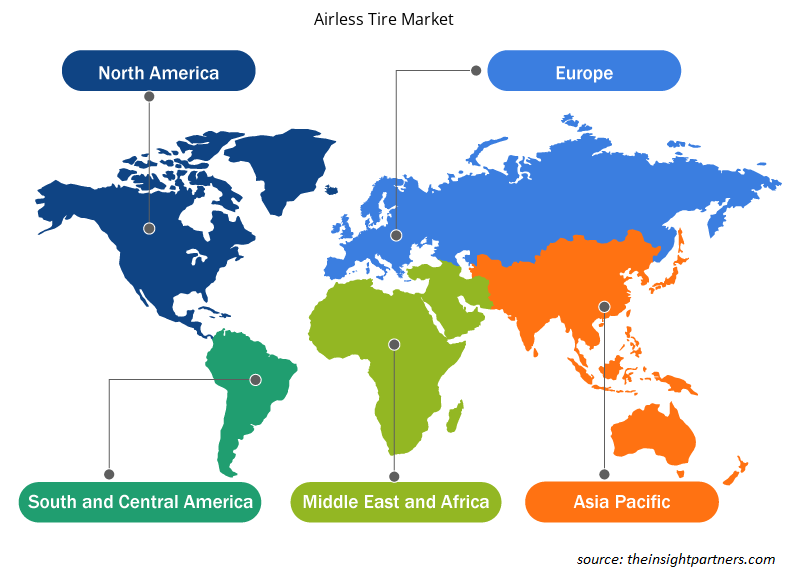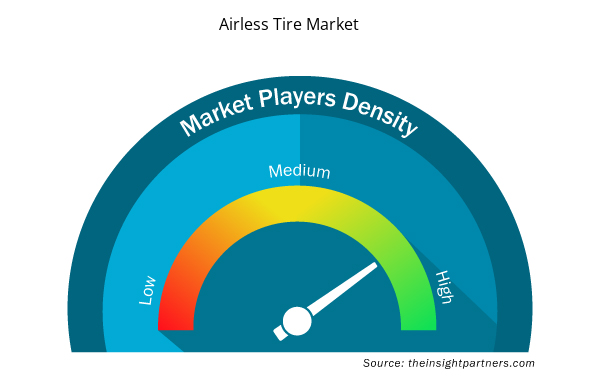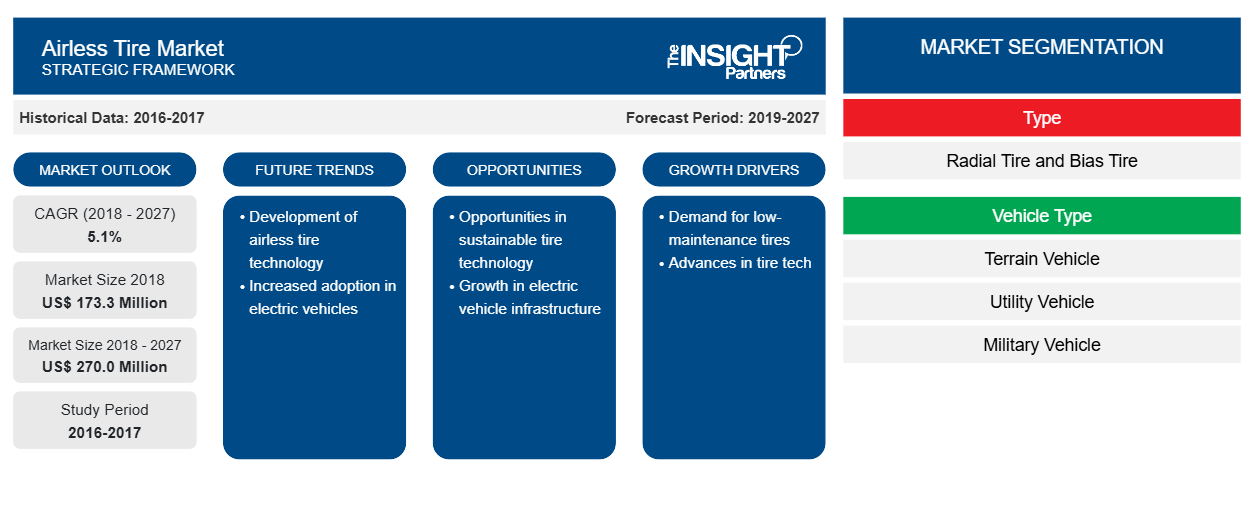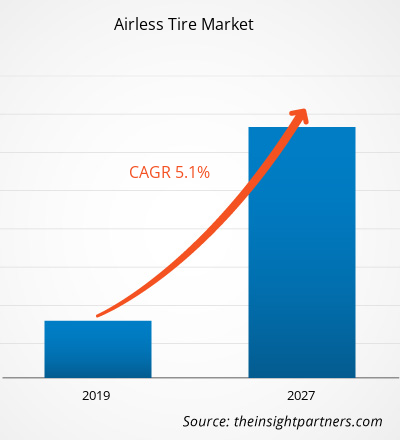In termini di fatturato, il mercato globale degli pneumatici airless è stato valutato a 173,3 milioni di dollari nel 2018 e si prevede che raggiungerà i 270,0 milioni di dollari entro il 2027; si prevede una crescita a un CAGR del 5,1% nel periodo di previsione dal 2019 al 2027.
Il mercato degli pneumatici airless è ampiamente segmentato in cinque regioni principali: Nord America, Europa, APAC, MEA e SAM. La regione più importante nel mercato globale degli pneumatici airless è rappresentata dal Nord America, seguita dall'Asia Pacifico e dall'Europa. Il predominio del Nord America nel mercato degli pneumatici airless è dovuto al fatto che la regione ospita diversi produttori di pneumatici airless, che capitalizzano in modo significativo sulla ricerca e sviluppo del prodotto. Gli Stati Uniti sono il mercato più grande del Nord America nonché il mercato globale degli pneumatici airless e si prevede che domineranno il mercato per tutto il periodo di previsione dal 2019 al 2027. Il mercato degli pneumatici airless in uno scenario globale è pronto a crescere durante il periodo di previsione. L'adozione degli pneumatici airless in diverse aree geografiche sta crescendo costantemente tra vari tipi di veicoli. I vantaggi offerti dagli pneumatici airless hanno influenzato diversi settori, tra cui edilizia, agricoltura, commercio, estrazione mineraria e militare. Il mercato degli pneumatici senza aria è in una fase iniziale e diverse aziende affermate, così come attori più piccoli, operano nel mercato globale
Personalizza questo report in base alle tue esigenze
Riceverai la personalizzazione gratuita di qualsiasi report, comprese parti di questo report, o analisi a livello nazionale, pacchetto dati Excel, oltre a usufruire di grandi offerte e sconti per start-up e università
- Scopri le principali tendenze di mercato in questo rapporto.Questo campione GRATUITO includerà analisi di dati che spaziano dalle tendenze di mercato alle stime e alle previsioni.
Approfondimenti di mercato: mercato degli pneumatici senza aria
Escalation nella produzione di veicoli in tutto il mondo
A livello globale, la tendenza all'urbanizzazione sta crescendo a un tasso di crescita esponenziale. A causa di ciò, anche il reddito medio disponibile della popolazione che vive nelle città urbane sta aumentando. La produzione di veicoli ha assistito a una crescita costante nell'era post-recessione dall'anno 2010. Un'area chiave è il settore delle attrezzature pesanti e dei veicoli utilitari che è caratterizzato da un alto livello di attività di innovazione e sviluppi correlati alla sicurezza stradale . L'aumento della flotta di veicoli ha portato a un aumento degli incidenti causato da vari fattori, come una pressione inappropriata degli pneumatici. Le attrezzature pesanti dotate di pneumatici senza aria sono in grado di trasportare più peso e di svolgere attività più impegnative rispetto agli pneumatici.
Tipo Segmento Insights
In base al tipo, ilil segmento degli pneumatici radiali ha dominato il mercato globale degli pneumatici airless nel 2018. In un design di pneumatico radiale, la disposizione delle tele di cordone è a 90 gradi rispetto alla direzione di marcia, o dal centro dello pneumatico (radialmente). Uno pneumatico radiale consente al battistrada e alla parete laterale di funzionare come due caratteristiche indipendenti dello pneumatico del veicolo.
Approfondimenti sui segmenti dei materiali
In base al materiale, il segmento della gomma ha dominato il mercato globale degli pneumatici airless. Uno pneumatico convenzionale è fatto di gomma racchiusa in aria e imballata con l'uso di aria compressa. Gli pneumatici stanno dominando il mercato globale degli pneumatici.
Informazioni sul segmento del tipo di veicolo
In base al tipo di veicolo, il segmento dei veicoli utilitari ha detenuto la quota maggiore nel mercato globale degli pneumatici airless nel 2018. I veicoli utilitari includono diversi tipi di veicoli che vengono utilizzati per numerose applicazioni industriali. Questi veicoli sono progettati e realizzati per svolgere compiti specifici in modo più efficace ed efficiente rispetto ai veicoli per passeggeri.
Gli operatori del mercato si concentrano su innovazioni e sviluppi di nuovi prodotti integrando tecnologie e funzionalità avanzate nei loro prodotti per competere con i concorrenti.
- Nel 2019, Michelin Tweel Technologies, una divisione di Michelin North America, Inc., ha introdotto un nuovo pneumatico radiale airless da 26 pollici con un mozzo con schema a quattro bulloni, progettato per UTV (veicoli utilitari o veicoli da lavoro utilitari).
- Nel 2018 Michelin ha avviato una partnership con General Motors per testare e collaudare il prototipo Uptis che equipaggerà le auto a partire dal 2024.
- Nel 2017, Toyo Tires ha annunciato lo sviluppo di “noair”, un pneumatico concept neo-futuristico senza aria che non necessita di alcun riempimento d'aria.
Il mercato globale degli pneumatici airless è stato segmentato come segue:
Mercato dei pneumatici senza aria – Per tipo
- Pneumatico radiale
- Pneumatico diagonale
Mercato dei pneumatici senza aria – Per materiale
- Gomma
- Composito
Mercato degli pneumatici senza aria – Per tipo di veicolo
- Veicolo terrestre
- Veicolo utilitario
- Veicolo militare
Mercato degli pneumatici senza aria - Per regione
- America del Nord
- NOI
- Canada
- Messico
- Europa
- Francia
- Germania
- Italia
- Regno Unito
- Russia
- Resto d'Europa
- Asia Pacifico (APAC)
- Cina
- India
- Corea del Sud
- Giappone
- Australia
- Resto dell'APAC
- Medio Oriente e Africa (MEA)
- Sudafrica
- Arabia Saudita
- Emirati Arabi Uniti
- Resto del MEA
- America del Sud (SAM)
- Brasile
- Argentina
- Resto del SAM
Approfondimenti regionali sul mercato degli pneumatici senza aria
Le tendenze regionali e i fattori che influenzano il mercato degli pneumatici senza aria durante il periodo di previsione sono stati ampiamente spiegati dagli analisti di Insight Partners. Questa sezione discute anche i segmenti e la geografia del mercato degli pneumatici senza aria in Nord America, Europa, Asia Pacifico, Medio Oriente e Africa e America meridionale e centrale.

- Ottieni i dati specifici regionali per il mercato degli pneumatici senza aria
Ambito del rapporto sul mercato degli pneumatici senza aria
| Attributo del report | Dettagli |
|---|---|
| Dimensioni del mercato nel 2018 | 173,3 milioni di dollari USA |
| Dimensioni del mercato entro il 2027 | 270,0 milioni di dollari USA |
| CAGR globale (2018 - 2027) | 5,1% |
| Dati storici | 2016-2017 |
| Periodo di previsione | 2019-2027 |
| Segmenti coperti | Per tipo
|
| Regioni e Paesi coperti | America del Nord
|
| Leader di mercato e profili aziendali chiave |
|
Densità degli attori del mercato: comprendere il suo impatto sulle dinamiche aziendali
Il mercato degli pneumatici Airless sta crescendo rapidamente, spinto dalla crescente domanda degli utenti finali dovuta a fattori quali l'evoluzione delle preferenze dei consumatori, i progressi tecnologici e una maggiore consapevolezza dei vantaggi del prodotto. Con l'aumento della domanda, le aziende stanno ampliando le loro offerte, innovando per soddisfare le esigenze dei consumatori e capitalizzando sulle tendenze emergenti, il che alimenta ulteriormente la crescita del mercato.
La densità degli operatori di mercato si riferisce alla distribuzione di aziende o società che operano in un particolare mercato o settore. Indica quanti concorrenti (operatori di mercato) sono presenti in un dato spazio di mercato in relazione alle sue dimensioni o al valore di mercato totale.
Le principali aziende che operano nel mercato degli pneumatici senza aria sono:
- Ameritria
- Società Bridgestone
- Società continentale
- Ruota dell'evoluzione
- Azienda produttrice di pneumatici Hankook.
Disclaimer : le aziende elencate sopra non sono classificate secondo un ordine particolare.

- Ottieni una panoramica dei principali attori del mercato degli pneumatici senza aria
Mercato dei pneumatici senza aria – Profili aziendali
- Ameritria
- Società Bridgestone
- Continentale
- Ruota dell'evoluzione
- Azienda produttrice di pneumatici Hankook.
- Industrie McLaren
- Michelin
- Azienda produttrice di gomma Sumitomo.
- La Goodyear Tire & Rubber Company
- Azienda Toyo Tire & Rubber Co. Ltd.,
- Analisi storica (2 anni), anno base, previsione (7 anni) con CAGR
- Analisi PEST e SWOT
- Valore/volume delle dimensioni del mercato - Globale, regionale, nazionale
- Industria e panorama competitivo
- Set di dati Excel



Report Coverage
Revenue forecast, Company Analysis, Industry landscape, Growth factors, and Trends

Segment Covered
This text is related
to segments covered.

Regional Scope
North America, Europe, Asia Pacific, Middle East & Africa, South & Central America

Country Scope
This text is related
to country scope.
Trends and growth analysis reports related to Automotive and Transportation : READ MORE..
The List of Companies - Airless Tire Market
- Amerityre
- Bridgestone Corporation
- Continental Corporation
- Evolution Wheel
- Hankook Tire & Technology Co. Ltd.
- McLaren Industries
- Michelin
- Sumitomo Rubber Industries Ltd.
- The Goodyear Tire & Rubber Company
- Toyo Tire & Rubber Co. Ltd.
The Insight Partners performs research in 4 major stages: Data Collection & Secondary Research, Primary Research, Data Analysis and Data Triangulation & Final Review.
- Data Collection and Secondary Research:
As a market research and consulting firm operating from a decade, we have published and advised several client across the globe. First step for any study will start with an assessment of currently available data and insights from existing reports. Further, historical and current market information is collected from Investor Presentations, Annual Reports, SEC Filings, etc., and other information related to company’s performance and market positioning are gathered from Paid Databases (Factiva, Hoovers, and Reuters) and various other publications available in public domain.
Several associations trade associates, technical forums, institutes, societies and organization are accessed to gain technical as well as market related insights through their publications such as research papers, blogs and press releases related to the studies are referred to get cues about the market. Further, white papers, journals, magazines, and other news articles published in last 3 years are scrutinized and analyzed to understand the current market trends.
- Primary Research:
The primarily interview analysis comprise of data obtained from industry participants interview and answers to survey questions gathered by in-house primary team.
For primary research, interviews are conducted with industry experts/CEOs/Marketing Managers/VPs/Subject Matter Experts from both demand and supply side to get a 360-degree view of the market. The primary team conducts several interviews based on the complexity of the markets to understand the various market trends and dynamics which makes research more credible and precise.
A typical research interview fulfils the following functions:
- Provides first-hand information on the market size, market trends, growth trends, competitive landscape, and outlook
- Validates and strengthens in-house secondary research findings
- Develops the analysis team’s expertise and market understanding
Primary research involves email interactions and telephone interviews for each market, category, segment, and sub-segment across geographies. The participants who typically take part in such a process include, but are not limited to:
- Industry participants: VPs, business development managers, market intelligence managers and national sales managers
- Outside experts: Valuation experts, research analysts and key opinion leaders specializing in the electronics and semiconductor industry.
Below is the breakup of our primary respondents by company, designation, and region:

Once we receive the confirmation from primary research sources or primary respondents, we finalize the base year market estimation and forecast the data as per the macroeconomic and microeconomic factors assessed during data collection.
- Data Analysis:
Once data is validated through both secondary as well as primary respondents, we finalize the market estimations by hypothesis formulation and factor analysis at regional and country level.
- Macro-Economic Factor Analysis:
We analyse macroeconomic indicators such the gross domestic product (GDP), increase in the demand for goods and services across industries, technological advancement, regional economic growth, governmental policies, the influence of COVID-19, PEST analysis, and other aspects. This analysis aids in setting benchmarks for various nations/regions and approximating market splits. Additionally, the general trend of the aforementioned components aid in determining the market's development possibilities.
- Country Level Data:
Various factors that are especially aligned to the country are taken into account to determine the market size for a certain area and country, including the presence of vendors, such as headquarters and offices, the country's GDP, demand patterns, and industry growth. To comprehend the market dynamics for the nation, a number of growth variables, inhibitors, application areas, and current market trends are researched. The aforementioned elements aid in determining the country's overall market's growth potential.
- Company Profile:
The “Table of Contents” is formulated by listing and analyzing more than 25 - 30 companies operating in the market ecosystem across geographies. However, we profile only 10 companies as a standard practice in our syndicate reports. These 10 companies comprise leading, emerging, and regional players. Nonetheless, our analysis is not restricted to the 10 listed companies, we also analyze other companies present in the market to develop a holistic view and understand the prevailing trends. The “Company Profiles” section in the report covers key facts, business description, products & services, financial information, SWOT analysis, and key developments. The financial information presented is extracted from the annual reports and official documents of the publicly listed companies. Upon collecting the information for the sections of respective companies, we verify them via various primary sources and then compile the data in respective company profiles. The company level information helps us in deriving the base number as well as in forecasting the market size.
- Developing Base Number:
Aggregation of sales statistics (2020-2022) and macro-economic factor, and other secondary and primary research insights are utilized to arrive at base number and related market shares for 2022. The data gaps are identified in this step and relevant market data is analyzed, collected from paid primary interviews or databases. On finalizing the base year market size, forecasts are developed on the basis of macro-economic, industry and market growth factors and company level analysis.
- Data Triangulation and Final Review:
The market findings and base year market size calculations are validated from supply as well as demand side. Demand side validations are based on macro-economic factor analysis and benchmarks for respective regions and countries. In case of supply side validations, revenues of major companies are estimated (in case not available) based on industry benchmark, approximate number of employees, product portfolio, and primary interviews revenues are gathered. Further revenue from target product/service segment is assessed to avoid overshooting of market statistics. In case of heavy deviations between supply and demand side values, all thes steps are repeated to achieve synchronization.
We follow an iterative model, wherein we share our research findings with Subject Matter Experts (SME’s) and Key Opinion Leaders (KOLs) until consensus view of the market is not formulated – this model negates any drastic deviation in the opinions of experts. Only validated and universally acceptable research findings are quoted in our reports.
We have important check points that we use to validate our research findings – which we call – data triangulation, where we validate the information, we generate from secondary sources with primary interviews and then we re-validate with our internal data bases and Subject matter experts. This comprehensive model enables us to deliver high quality, reliable data in shortest possible time.


 Ottieni un campione gratuito per questo repot
Ottieni un campione gratuito per questo repot